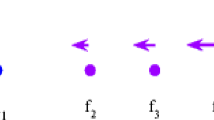Then it is again clear that nothing will remain, but it will be all gone...
Simplicius.
Abstract
A supertask consists in the performance of an infinite number of actions in a finite time. I show that any attempt to carry out a supertask will produce a divergence of the curvature of spacetime, resulting in the formation of a black hole. I maintain that supertaks, contrarily to a popular view among philosophers, are physically impossible. Supertasks, literally, collapse under their own weight.
Similar content being viewed by others
Notes
Since
$$\begin{aligned} \frac{1}{2}+\frac{1}{4}+\frac{1}{8}+\frac{1}{16}+\cdots = \sum \limits _{n=0}^\infty \frac{1}{2}\left( {\frac{1}{2}}\right) ^n = \frac{\frac{1}{2}}{1-\frac{1}{2}} = 1. \end{aligned}$$Both the Ricci tensor and the Ricci scalar are zero in a flat spacetime since they are formed with the second derivatives of the metric.
Some peculiar choices for \(T_{\mu \nu }\) might lead to a divergence of the curvature without the occurrence of an event horizon, in violation of the CCC (e.g. Joshi 1993). Whether such configurations of energy and momentum can be obtained in Nature is highly controversial. In any case, the execution of the supertask is terminated not by the event horizon, but by tidal forces associated with the increase of the curvature which necessarily follows from the rise of the energy density.
A time-like curve is a curve that can be followed by a massive system.
A null curve is a curve that can be followed by photons or other bosons moving at the speed of light.
A region to which can evolve causal curves from a region located in the past of the black hole.
See the Appendix.
The Planck time is \(t_\mathrm{P} \equiv \sqrt{\frac{\hbar G}{c^5}}\approx 5.39106(32) \times 10^{-44}\) s.
References
Benacerraf, P. (1962). Tasks, super-tasks, and modern Eleatics. Journal of Philosophy, LIX, 765–784.
Bunge, M. (1967). Foundations of physics. New York: Springer.
Bunge, M. (1977). Ontology I: The furniture of the world. Dordrecht: Kluwer.
Hawking, S. W., & Ellis, G. F. R. (1973). The large scale structure of space-time. Cambridge: Cambridge University Press.
Joshi, P. S. (1993). Global aspects in gravitation and cosmology. Oxford: Oxford Clarendon Press.
Mandelshtam, L. I., & Tamm, I. E. (1945). The uncertainty relation between energy and time in nonrelativistic quantum mechanics. Journal of Physics, IX, 249–254.
Perez Bergliaffa, S. E., Romero, G. E., & Vucetich, H. (1993). Axiomatic foundations of non-relativistic quantum mechanics: A realistic approach. International Journal of Theoretical Physics, 32, 1507–1522.
Perez Bergliaffa, S. E., Romero, G. E., & Vucetich, H. (1998). Toward an axiomatic pregeometry of space-time. International Journal of Theoretical Physics, 37, 2281–2298.
Pérez Laraudogoitia, J. (1996). A beautiful supertask. Mind, 105, 81–83.
Pérez Laraudogoitia, J. (2011). Supertasks, the Stanford encyclopedia of philosophy. In Edward N. Zalta (ed.), URL: http://plato.stanford.edu/archives/spr2011/entries/spacetime-supertasks/.
Romero, G. E. (2013a). From change to spacetime: An eleatic journey. Foundations of Science, 18, 139–148.
Romero, G. E. (2013b). Adversus singularitates: The ontology of spacetime singularities. Foundations of Science, 18, 297–306.
Thomson, J. (1954). Tasks and super-tasks. Analysis, XV, 113.
Weyl, H. (1928). Gruppentheorie Und Quantenmechanik. Leipzig: Hirzel.
Author information
Authors and Affiliations
Corresponding author
Appendix: Quantum Indetermination Theorems
Appendix: Quantum Indetermination Theorems
The relation (4) given above is different from the usual inequality presented in many textbooks:
This inequality cannot be derived from the framework of quantum mechanics, since, as noted by Bunge (1967) and Perez Bergliaffa et al. (1993) among others, there is no time operator in the theory. The inequalities between properties represented by non-commuting operators are derived using the Schwarz inequality (Weyl 1928), i.e. if \(\hat{A}\hbox { and }\hat{B}\) are two operators representing the quantum properties \(A\hbox { and }B\) such that
then, through \((\Delta A)^{2}(\Delta B)^{2}\ge \frac{1}{2}\left| \hat{A}\hat{B}\right| \), we get
where \(\Delta \) indicates the root–mean–square deviation of the corresponding operators. In particular, since the position and momentum operators satisfy \([\hat{q_{i}}, \; \hat{p_{j}}]=i \hbar \delta _{ij}\), the usual relation \(\Delta q_{r} \Delta p_{r}\ge \hbar /2\) obtains.
This procedure fails when applied to the Hamiltonian that represents the energy of the system and time, since time is a parameter. In 1945, Mandelshtam and Tamm obtained the correct form for an energy-time relation, where the time involved was the timescale of an evolving operator. This relation is given by inequality (4).
Rights and permissions
About this article
Cite this article
Romero, G.E. The Collapse of Supertasks. Found Sci 19, 209–216 (2014). https://doi.org/10.1007/s10699-013-9338-7
Published:
Issue Date:
DOI: https://doi.org/10.1007/s10699-013-9338-7



